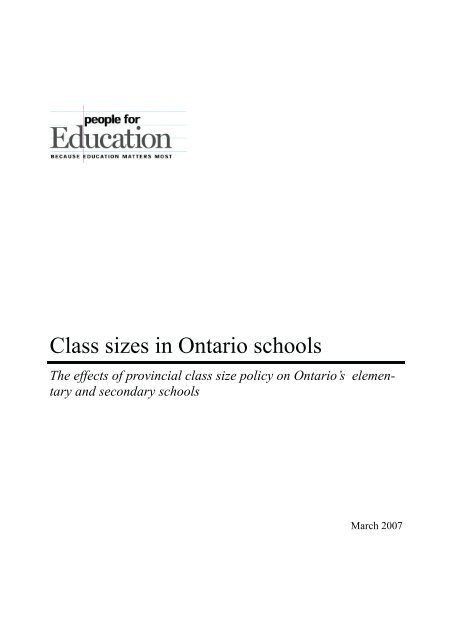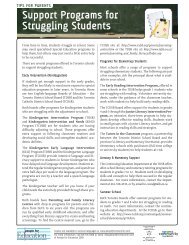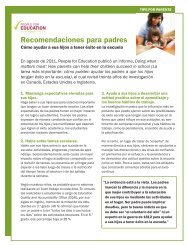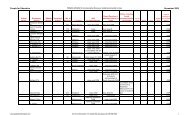Class sizes in Ontario schools - People for Education
Class sizes in Ontario schools - People for Education
Class sizes in Ontario schools - People for Education
You also want an ePaper? Increase the reach of your titles
YUMPU automatically turns print PDFs into web optimized ePapers that Google loves.
<strong>Class</strong> <strong>sizes</strong> <strong>in</strong> <strong>Ontario</strong> <strong>schools</strong><br />
The effects of prov<strong>in</strong>cial class size policy on <strong>Ontario</strong>’s elementary<br />
and secondary <strong>schools</strong><br />
March 2007
© <strong>People</strong> <strong>for</strong> <strong>Education</strong>, 2006<br />
<strong>People</strong> <strong>for</strong> <strong>Education</strong> is a registered charity work<strong>in</strong>g to support<br />
public education <strong>in</strong> <strong>Ontario</strong>’s English, French and Catholic <strong>schools</strong>.<br />
P.O. Box 64, Station P<br />
Toronto, <strong>Ontario</strong><br />
M5S 2S6<br />
phone: 416-534-0100<br />
fax: 416-536-0100<br />
e-mail: p4e@people<strong>for</strong>education.com<br />
website: www.people<strong>for</strong>education.com<br />
2
<strong>Class</strong> Size <strong>People</strong> <strong>for</strong> <strong>Education</strong> 2007<br />
CLASS SIZES IN ONTARIO SCHOOLS<br />
<strong>Class</strong> size has been the object of extensive debate <strong>in</strong> recent years. Some<br />
researchers argue that class size has little effect on student achievement,<br />
while others feel that class size – particularly <strong>in</strong> the early grades and<br />
particularly <strong>for</strong> students who are “educationally disadvantaged” – makes a<br />
significant difference to students’ chances <strong>for</strong> success <strong>in</strong> school.<br />
In <strong>Ontario</strong>, recent changes to government policy and targeted fund<strong>in</strong>g have<br />
had a considerable impact on class <strong>sizes</strong> <strong>in</strong> elementary <strong>schools</strong>. Though<br />
there rema<strong>in</strong>s a wide range of class <strong>sizes</strong> across the prov<strong>in</strong>ce, 98% of<br />
<strong>Ontario</strong>’s K<strong>in</strong>dergarten to Grade 3 classes now have 25 students or fewer.<br />
But many boards are struggl<strong>in</strong>g to meet the prov<strong>in</strong>ce’s cap of 20 students or<br />
fewer <strong>for</strong> all primary grades. It may be time to make the prov<strong>in</strong>cial policy<br />
more flexible and allow boards to provide the smallest classes <strong>in</strong> the areas<br />
where they will have the largest impact, and allow <strong>schools</strong> some flexibility<br />
to ensure there is not a dramatic <strong>in</strong>crease <strong>in</strong> multi-grade or split classes.<br />
Overall class <strong>sizes</strong> <strong>in</strong> elementary <strong>schools</strong> <strong>in</strong> 2007:<br />
50%<br />
45%<br />
40%<br />
35%<br />
K<strong>in</strong>dergarten to Grade 8 <strong>Class</strong>es<br />
With 26 Students or More<br />
• 76% of K<strong>in</strong>dergarten to Grade 8 classes<br />
had 25 students or fewer, compared to<br />
51% <strong>in</strong> 1997/98;<br />
• 20% of classes had 26 to 30 students,<br />
compared to 36% <strong>in</strong> 1997/98; and<br />
• 4% of classes had 31 or more students,<br />
compared to 13% <strong>in</strong> 1997/98.<br />
30%<br />
25%<br />
20%<br />
1998/99 2000/01 2002/03 2004/05 2006/07<br />
1997/98 1999/00 2001/02 2003/04 2005/06<br />
3
<strong>Class</strong> Size <strong>People</strong> <strong>for</strong> <strong>Education</strong> 2007<br />
K<strong>in</strong>dergarten to Grade 3 <strong>Class</strong> Sizes<br />
In 2004/05, the M<strong>in</strong>istry of <strong>Education</strong> <strong>in</strong>troduced fund<strong>in</strong>g to reduce class<br />
<strong>sizes</strong> <strong>in</strong> the primary grades. The goal of the fund<strong>in</strong>g was to ensure that by<br />
2007/08, no primary class had more than 20 students.<br />
In 2006, the M<strong>in</strong>istry of <strong>Education</strong> amended the policy slightly. Boards will<br />
now be considered compliant if 90% of their primary classes have 20<br />
students or fewer and up to 10 per cent have up to 23 students. The new<br />
policy also stated that it is “expected that boards will achieve compliance<br />
while ensur<strong>in</strong>g that average class size <strong>in</strong> the other elementary grades (4 to 8)<br />
does not <strong>in</strong>crease.”<br />
The cap on primary class<br />
size is terrific but to keep<br />
spend<strong>in</strong>g <strong>in</strong> check, it<br />
should be kept as a “soft”<br />
rather than “hard cap”.<br />
This would also give<br />
<strong>schools</strong> greater flexibility<br />
with their organizations.<br />
And it would help to<br />
negate potential staff<br />
morale difficulties<br />
between junior and<br />
primary teachers.<br />
JK to Grade 6<br />
elementary school<br />
Waterloo Region<br />
This year, 98% of K<strong>in</strong>dergarten to Grade 3 classes have 25 students or<br />
fewer. While this is not with<strong>in</strong> the M<strong>in</strong>istry’s 20-student cap, it is a<br />
significant improvement <strong>in</strong> the last three years. But, even with <strong>in</strong>creased<br />
fund<strong>in</strong>g, it will be very difficult <strong>for</strong> boards to meet the M<strong>in</strong>istry target by the<br />
fall of 2007.<br />
K<strong>in</strong>dergarten to Grade 3 classes <strong>in</strong> 2006/07:<br />
• 58% of primary classes had 20 students or fewer, a substantial <strong>in</strong>crease<br />
from 36% <strong>in</strong> 2004/05;<br />
• 40% of primary classes had between 21 and 25 students, compared to<br />
53% of classes <strong>in</strong> 2004/05; and<br />
• Only 2% of primary classes had 26 students or more, a significant<br />
improvement from 11% <strong>in</strong> 2004/05.<br />
<strong>Class</strong> Sizes - K<strong>in</strong>dergarten to Grade 3<br />
2006/07<br />
98%<br />
98%<br />
20 students or fewer<br />
58%<br />
26 students or more<br />
2%<br />
21 to 25 students<br />
40%<br />
4
<strong>Class</strong> Size <strong>People</strong> <strong>for</strong> <strong>Education</strong> 2007<br />
Split <strong>Class</strong>es<br />
One of the un<strong>in</strong>tended consequences of hard caps on class size has been an<br />
<strong>in</strong>crease <strong>in</strong> the number of split grades. This is particularly true <strong>in</strong> small<br />
<strong>schools</strong> and <strong>in</strong> <strong>schools</strong> with specialized programs, such as French Immersion.<br />
• Prov<strong>in</strong>ce-wide, the percentage of classes with 3 or more grades has risen<br />
from 5% <strong>in</strong> 2006, to 8% this year.<br />
We would love to take<br />
advantage of class size<br />
reduction <strong>in</strong>itiatives, but<br />
have absolutely no space<br />
<strong>for</strong> an additional classroom.<br />
We’ll require additional<br />
portables to meet<br />
M<strong>in</strong>istry requirements <strong>for</strong><br />
next year.<br />
JK to Grade 5<br />
elementary school<br />
Peel<br />
• In northern <strong>schools</strong>, which are on average much smaller than <strong>schools</strong> <strong>in</strong><br />
the rest of the prov<strong>in</strong>ce, the percentage of split classes with 3 or more<br />
grades has nearly doubled – from 12% <strong>in</strong> 2006, to 23% this year.<br />
Grades 4 to 8<br />
Parents have been concerned that reductions <strong>in</strong> primary class <strong>sizes</strong> will result<br />
<strong>in</strong> <strong>in</strong>creases <strong>in</strong> class <strong>sizes</strong> <strong>in</strong> grades 4 to 8. Though there is a substantial<br />
difference between primary class <strong>sizes</strong> and those <strong>in</strong> junior and senior grades,<br />
there is no overall evidence of <strong>in</strong>creased class <strong>sizes</strong> <strong>in</strong> grades 4 to 8. Only <strong>in</strong><br />
Eastern <strong>Ontario</strong>, which <strong>in</strong>cludes the Ottawa-Carleton school boards, has<br />
there been an <strong>in</strong>crease this year <strong>in</strong> the number of 4 to 8 classes with 26<br />
students or more.<br />
60%<br />
58%<br />
<strong>Class</strong> <strong>sizes</strong> <strong>in</strong> Grades 4 to 8 <strong>in</strong> 2007:<br />
Comparison of <strong>Class</strong> Sizes<br />
K to 3 and 4 to 8<br />
• 11% of classes had 20 students or<br />
fewer, compared to 10% <strong>in</strong> the previous<br />
two years;<br />
50%<br />
40%<br />
30%<br />
40%<br />
40% 41%<br />
20%<br />
11%<br />
10%<br />
8%<br />
2%<br />
0<br />
0<br />
21 to 25 students<br />
31 students or mo<br />
20 students or fewer<br />
26 to 30 students<br />
• 40% of classes had 21 to 25 students,<br />
compared to 35% <strong>in</strong> 2004/05;<br />
• 41% of classes had 26 to 30 students,<br />
compared to 47% <strong>in</strong> 2004/05; and<br />
• 8% had 31 students or more,<br />
unchanged over the last two years.<br />
K<strong>in</strong>dergarten to Grade 3<br />
Grade 4 to 8<br />
5
<strong>Class</strong> Size <strong>People</strong> <strong>for</strong> <strong>Education</strong> 2007<br />
Regional Variations<br />
There are wide variations <strong>in</strong> class <strong>sizes</strong> across the prov<strong>in</strong>ce. These<br />
variations reflect regional factors. Regions with lower enrolment are more<br />
likely to have smaller class <strong>sizes</strong> <strong>in</strong> the primary grades. Regions which had<br />
the vast majority of their primary classes above the planned cap <strong>in</strong> 2004<br />
have had to make substantial changes to meet the government’s target.<br />
Changes <strong>in</strong> percentage of primary classes<br />
at or under 20 students<br />
2004/05 2006/07 % change<br />
Northern 56% 69% + 23%<br />
Central 40% 64% + 60%<br />
Eastern 39% 54% + 38%<br />
GTA 26% 53% + 104%<br />
Southwestern 37% 62% + 68%<br />
90%<br />
80%<br />
In areas like the Greater Toronto Area, which <strong>in</strong>cludes the Toronto school<br />
boards, York, Durham, Halton, Duffer<strong>in</strong> and Peel, a number of factors<br />
come <strong>in</strong>to play. In boards with grow<strong>in</strong>g populations it has been difficult to<br />
provide the classroom space required to<br />
accommodate the <strong>in</strong>creased number of<br />
primary classes. In the Toronto boards,<br />
there may be some empty space, but<br />
not necessarily <strong>in</strong> the <strong>schools</strong> where<br />
more classes are required.<br />
Percentage of K<strong>in</strong>dergarten to Grade 3 <strong>Class</strong>es<br />
With 20 Students or Fewer, by Region<br />
70%<br />
69%<br />
64%<br />
62%<br />
60%<br />
54% 53%<br />
50%<br />
40%<br />
Northern<br />
Central<br />
Eastern<br />
GTA<br />
Southwestern<br />
6
<strong>Class</strong> Size <strong>People</strong> <strong>for</strong> <strong>Education</strong> 2007<br />
There are also regional variations <strong>in</strong> the size of classes <strong>in</strong> grades 4 to 8.<br />
Percentage of Grade 4 to 8 <strong>Class</strong>es<br />
With 26 Students or More, by Region<br />
70%<br />
60%<br />
50%<br />
62%<br />
50%<br />
46%<br />
57%<br />
40%<br />
30%<br />
30%<br />
20%<br />
10%<br />
0<br />
Northern Central Eastern GTA Southwestern<br />
<strong>Class</strong> Sizes <strong>in</strong> Secondary Schools<br />
In secondary school, <strong>People</strong> <strong>for</strong> <strong>Education</strong> tracks only classes that every<br />
student must take <strong>in</strong> every grade. In English-language boards, participants<br />
report on the <strong>sizes</strong> of core English classes, and <strong>in</strong> French-language <strong>schools</strong><br />
they report on core French classes.<br />
Secondary School Compulsory<br />
English or French <strong>Class</strong>es with 23 Students or More<br />
80%<br />
S<strong>in</strong>ce 2000/01, there have been<br />
gradual reductions <strong>in</strong> the size of<br />
these classes across the prov<strong>in</strong>ce.<br />
75%<br />
73%<br />
70%<br />
70%<br />
68%<br />
65%<br />
66%<br />
64%<br />
60%<br />
2002/03 2003/04 2004/05 2005/06 2006/07<br />
7
<strong>Class</strong> Size <strong>People</strong> <strong>for</strong> <strong>Education</strong> 2007<br />
“By 2007-08, at any given<br />
time, the numbers of<br />
students <strong>in</strong> primary<br />
classes will be 20<br />
students, n<strong>in</strong>e times out of<br />
10. Exceptions will only be<br />
allowed <strong>in</strong> the rema<strong>in</strong><strong>in</strong>g<br />
10 per cent of classes. Up<br />
to three additional<br />
students will be allowed as<br />
a result of enrolment<br />
changes to m<strong>in</strong>imize the<br />
number of split grades and<br />
avoid unnecessary<br />
transportation of<br />
students.”<br />
Premier Dalton McGu<strong>in</strong>ty<br />
Research on <strong>Class</strong> Size<br />
The reduction of class size has drawn conflict<strong>in</strong>g views among pedagogical<br />
researchers. The impact of class size on student achievement has been<br />
weighed aga<strong>in</strong>st the cost of staff<strong>in</strong>g smaller classes, or spend<strong>in</strong>g educational<br />
dollars <strong>in</strong> other areas, such as remedial support.<br />
The Canadian Council on Learn<strong>in</strong>g has written that smaller class <strong>sizes</strong> have<br />
greatest benefit <strong>in</strong> the primary grades, but also cautions that class <strong>sizes</strong><br />
should be reduced carefully, monitored, and that the cost benefit ratios be<br />
determ<strong>in</strong>ed.<br />
The C.D. Howe Institute concludes that “Because reduc<strong>in</strong>g class size is<br />
enormously expensive, it is very likely that the money be<strong>in</strong>g spent there<br />
could be better spent on other educational policies, such as cont<strong>in</strong>uous<br />
teacher tra<strong>in</strong><strong>in</strong>g, which, unlike class size reduction, have been shown to<br />
improve student per<strong>for</strong>mance.”<br />
In a brief on class size, The Society <strong>for</strong> the Advancement of Excellence <strong>in</strong><br />
<strong>Education</strong> (SAEE) emphasized that flexibility be <strong>in</strong>tegral to class size<br />
reduction to “suit emerg<strong>in</strong>g needs”, and that additional classroom space<br />
must be factored <strong>in</strong>to the reductions.<br />
There is, however, significant agreement that the benefits of small classes<br />
are greatest <strong>for</strong> students who have faced educational disadvantages, and that<br />
these ga<strong>in</strong>s are long-term <strong>in</strong> their effect, and carry on to upper grades and<br />
beyond.<br />
8
<strong>Class</strong> Size <strong>People</strong> <strong>for</strong> <strong>Education</strong> 2007<br />
Conclusion<br />
In only three years, prov<strong>in</strong>cial policy on primary class size has had a<br />
substantial impact. But it is important now to weigh the costs and the<br />
benefits of mov<strong>in</strong>g to a hard cap by the fall of 2007.<br />
The class size policy has cost $90 million per year over the last three years.<br />
It will require a significant <strong>in</strong>crease <strong>in</strong> class size fund<strong>in</strong>g <strong>for</strong> the com<strong>in</strong>g<br />
school year, if the prov<strong>in</strong>ce is to reach its target of 90% of primary classes<br />
at 20 students or fewer. And there are many other demands on prov<strong>in</strong>cial<br />
education fund<strong>in</strong>g.<br />
The re-organization necessary to produce a hard cap on class <strong>sizes</strong> has also<br />
been difficult to manage <strong>for</strong> many boards. In areas of high growth such as<br />
Halton, Peel and York Region, boards have had to provide new space <strong>for</strong><br />
the extra classes—space which is currently at a premium <strong>in</strong> those areas. In<br />
boards with low or decl<strong>in</strong><strong>in</strong>g enrolment the new policy has often resulted <strong>in</strong><br />
an <strong>in</strong>crease <strong>in</strong> split classes.<br />
Research on class size shows that it is important to weigh the costs of<br />
overall reductions <strong>in</strong> class size aga<strong>in</strong>st the potential benefits of other uses<br />
<strong>for</strong> the fund<strong>in</strong>g, such as full-day k<strong>in</strong>dergarten, technology and arts<br />
programs, early literacy programs or flexible fund<strong>in</strong>g that allows boards to<br />
provide very small classes <strong>for</strong> students at greater risk because of their<br />
socio-economic status.<br />
The Canadian Council on Learn<strong>in</strong>g, <strong>in</strong> its report on class size, recommends<br />
that governments monitor the impact of lower class <strong>sizes</strong> to determ<strong>in</strong>e the<br />
effect on student success and to determ<strong>in</strong>e the cost benefit.<br />
Reduc<strong>in</strong>g class <strong>sizes</strong> <strong>in</strong> the early grades was an election promise of the<br />
current government. As we can see, that promise has been kept. <strong>Class</strong><br />
<strong>sizes</strong> are lower overall, and much lower <strong>in</strong> the primary grades. It may be<br />
time to use the lessons learned over the last two years of implement<strong>in</strong>g the<br />
new class size policy, and consider adjust<strong>in</strong>g the “hard cap” policy to make<br />
it more flexible and more responsive to students’ needs.<br />
9
<strong>Class</strong> Size <strong>People</strong> <strong>for</strong> <strong>Education</strong> 2007<br />
Recommendations<br />
We recommend that the prov<strong>in</strong>ce:<br />
1. adjust the primary class size policy to allow more flexibility <strong>for</strong><br />
boards and school pr<strong>in</strong>cipals to implement small classes <strong>in</strong> specific<br />
areas;<br />
2. analyse the effects of the current reductions <strong>in</strong> class size on all aspects<br />
of student success, be<strong>for</strong>e mov<strong>in</strong>g <strong>for</strong>ward with the implementation of<br />
a hard cap;<br />
3. amend the fund<strong>in</strong>g <strong>for</strong>mula to ensure that fund<strong>in</strong>g <strong>for</strong> school<br />
operations and ma<strong>in</strong>tenance matches the actual costs;<br />
4. amend the fund<strong>in</strong>g <strong>for</strong>mula to ensure that fund<strong>in</strong>g <strong>for</strong> non-teach<strong>in</strong>g<br />
salaries more closely matches the amounts boards actually pay;<br />
5. re<strong>in</strong>state the Local Priorities Grant to allow boards more flexibility to<br />
target fund<strong>in</strong>g to areas of high need;<br />
6. re-evaluate and adequately fund the Learn<strong>in</strong>g Opportunities Grant<br />
which some boards used to cover the costs of smaller class <strong>sizes</strong> <strong>in</strong><br />
high needs areas and full-day k<strong>in</strong>dergarten <strong>for</strong> students who may not<br />
start Grade 1 ready to learn.<br />
10
<strong>Class</strong> Size <strong>People</strong> <strong>for</strong> <strong>Education</strong> 2007<br />
Methodology<br />
Every year <strong>People</strong> <strong>for</strong> <strong>Education</strong> conducts a survey of resources <strong>in</strong> <strong>Ontario</strong><br />
<strong>schools</strong>. Surveys were mailed with an explanatory letter to every <strong>Ontario</strong><br />
elementary and secondary school <strong>in</strong> October 2006. Translated surveys<br />
were sent to French-language <strong>schools</strong>. Responses were returned by fax or<br />
mail between October 2006 and February 2007.<br />
The results were compiled. Only compiled data is released. This year’s<br />
sample of 956 <strong>schools</strong> equals 20% of the prov<strong>in</strong>ce’s elementary and<br />
secondary <strong>schools</strong>.<br />
Fifty-seven per cent of <strong>schools</strong> <strong>in</strong> the sample participated last year.<br />
Northern <strong>Ontario</strong><br />
Schools were sorted accord<strong>in</strong>g to their<br />
postal codes <strong>in</strong>to geographic regions.<br />
Eighteen per cent of <strong>schools</strong> were located<br />
<strong>in</strong> the K postal code region, 23% were<br />
located <strong>in</strong> the L postal code region, 18%<br />
were located <strong>in</strong> the M postal code region,<br />
22% were located <strong>in</strong> the N postal code<br />
region and 18% were located <strong>in</strong> the P<br />
postal code region.<br />
Central <strong>Ontario</strong><br />
Southwestern <strong>Ontario</strong><br />
Toronto<br />
Eastern <strong>Ontario</strong><br />
For the purpose of regional comparisons, we sorted <strong>schools</strong> <strong>in</strong>to the<br />
regional area of Greater Toronto. The Greater Toronto Area <strong>in</strong>cludes all<br />
the <strong>schools</strong> <strong>in</strong> Toronto (M postal code) and <strong>schools</strong> <strong>in</strong> the Regional<br />
Municipalities of Durham, Peel, Halton and York (all part of the L postal<br />
code). The Central Region <strong>in</strong> the report <strong>in</strong>cludes all the <strong>schools</strong> <strong>in</strong> the L<br />
postal code, less the <strong>schools</strong> <strong>in</strong> the Greater Toronto Area.<br />
11
<strong>Class</strong> Size <strong>People</strong> <strong>for</strong> <strong>Education</strong> 2007<br />
References<br />
Canadian Council on Learn<strong>in</strong>g, “Mak<strong>in</strong>g Sense of the <strong>Class</strong> Size<br />
Debate” (September 2005), http://www.ccl-cca.ca/cgi-b<strong>in</strong>/<br />
MsmGo.exe?grab_id=0&page_id=115&query=%22class%20size%<br />
22&hiword=CLASSE%20CLASSED%20CLASSES%20CLASSIC%<br />
20SIZEABLE%20SIZED%20SIZES%20class%20size%20.<br />
Yvan Guillemette, “School <strong>Class</strong> Size: Smaller Isn’t Better”, <strong>in</strong> C.D. Howe<br />
Institute Commentary (August 2005), http://www.cdhowe.org/pdf/<br />
commentary_215.pdf ).<br />
Kather<strong>in</strong>e Wagner, “<strong>Class</strong> Size Policy” The Society <strong>for</strong> the Advancement of<br />
Excellence <strong>in</strong> <strong>Education</strong> (Spr<strong>in</strong>g 2001), http://www.saee.ca/policy/<br />
D_014_BBZ_LON.php.<br />
12
















